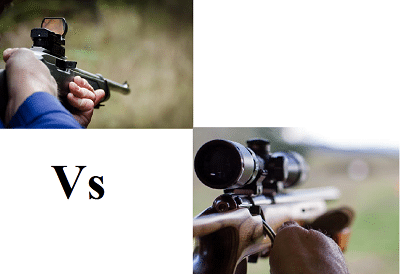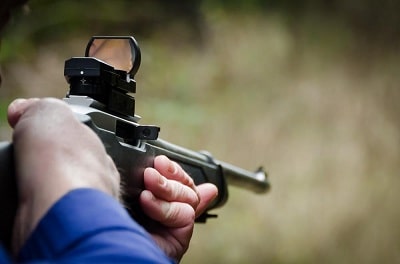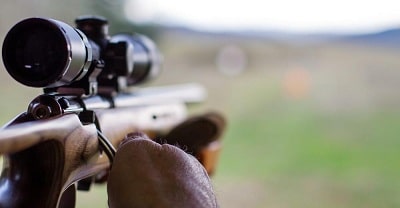One of the more common issues of discussion among frequent shooters is that of red dot vs scope.

Red dot vs Scope
Many hunters wonder which one is better for what type of situation, and if there is ever a time when they should be partial to both.
Personally, I’m a big fan of modern technology when it comes to guns, so the red dot puts me in a sort of heaven.
But today we’ll look at the what red dot and scope are, and what are the differences between them.
What is a Red Dot and what is a Scope?
So what is the red dot?
Simply put, a red dot is like an optical illusion. Inside a tube or other enclosure on top of the gun, a red dot will be projected onto a screen.
This dot, which is sometimes a line, reticle, or other red honing notation of some kind, appears to be at the same distance as the target. The goal is two-fold:
- Help the shooter identify the distance between him or herself and the target
- Improve accuracy and eye line by focusing on the dot
What about a scope?
Contrast this with a scope, which is purely meant to magnify the target and increase the line of sight on it by the shooter.
There is no red line or marking of any kind, it’s basically the same as looking through a telescope, magnifying glass, or other optical funnel.
Here is a great video on the subject:
What are the Pros and Cons of Red Dots and Scopes?
Pros and Cons of the Red Dot
There is a reason why red dot scopes have become so heavily used in the military and other high-pressure, intense situations. It is because in short range, rapid fire scenarios, the shooter can aim quicker, follow a moving target with more accuracy, and generally increase their odds of a hit.

The Rifle with Red Dot
The tube of light hits the concave glass lens. The light the shooter sees is the reflection of that light and for field situations, it really helps with accuracy and tracking.
I find that the red dots also help a lot with pinpointing an area on the target that I want to hit while the target is moving. Perhaps that’s because I can make the dot hit that spot for at least a brief second.
No matter the reason, I can’t get that perk with a scope or without using any magnification at all. I also like the ability to subtend either 2, 3, or 4 minutes at 100 years. I most often use the 2 minute option, but have found myself at 3 several times.
On the downside, red dots don’t help as much as a traditional scope with overall accuracy.
You’re also dealing with a battery that may cause issues. This isn’t going to be a problem for those shooters who are fanatical about maintenance and double checking that everything is ready to go before heading into the field.
You should choose one of the best red dot for ar 15, the best quality red dot has been list on that article, move on and get one for your.
But if you’re sloppy, you may be caught off guard with no dot when you need it most. Here is a video on using a red dot scope:
What About the Magnified Optic Scope?
The biggest plus to using a scope instead of a red dot is that many of them have variable power settings, and can be adjusted much easier than the red dot devices.

The rifle with Magnified Scope
Another plus is that the scope is more versatile for both close and long range shooting situations. The varied settings of the scope allow for easy adjustment to fit your specific circumstance.
The scope is, overall, better for accuracy and hit percentage.
On the negative side:
I seem to find it difficult to hit a target at the exact point I’m shooting for. While the scope brings the target into focus well, it does little to help shooters hit a precise point beyond making that point larger in their field of view.
Additionally, I find scopes to be harder to adjust my eyes to specifically because they don’t really do anything other than magnify and focus. I appreciate them holding zero, and am not trying to say I don’t find any value in magnified optic scopes. But for specific shooting in high-pressure situations, they fall behind.
Here is a video on how to sight your rifle scope.
Situational Comparison between Red Dot and the Magnified Optics Scope
Let’s go over a couple of scenarios here and decide whether the red dot or the scope is better.
Scenario 1: Short range white tail hunte.
- The short range gives to the red dot.
- The quick movement and easy startling of the animal gives to the scope. This is close- I’ve noted red dots ability to move quickly, but because the accuracy is better overall with the scope, it wins this point
- The ability to hit the body where you prefer gives a point to the red dot here
- Overall winner: red dot
Scenario 2: long-range hunt or hunt of target at higher elevation than the shooter
- Need for increase accuracy gives a point to the scope
- The flying target or uphill moving target definitely goes to the red dot, because you can follow the part of the target that you wish to hit with a higher degree of precision
- The parallax issue comes into play here as the target moves further away or changes elevation. The red dot, as long as it is in view, can stay over the target and reduce the effect of the parallax issue. Point to the red dot
- Overall winner: red dot
Conclusion
Now, obviously there is a lot of my personal experience and opinion in this article.
Long-time scope users will come forward saying that the long-distance competition should have gone to the scope. They are correct assuming that their comfort level with the scope is much higher than with the red dot. Other than that, I fail to see how the scope would win.
Overall, I like the red dot much better because of the parallax issue and short distance accuracy. I keep good track of my battery power and other small details, so I never have any problems there.
I’d love to hear your thoughts on this. Go ahead and throw your comments in the section down below, and please share on social media. Let’s get a good conversation going!
